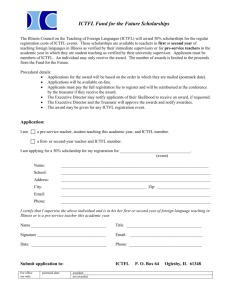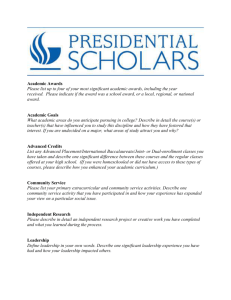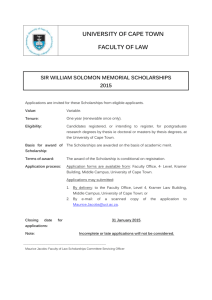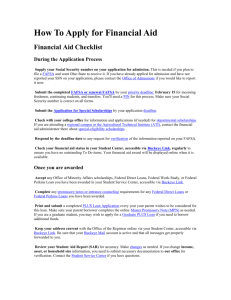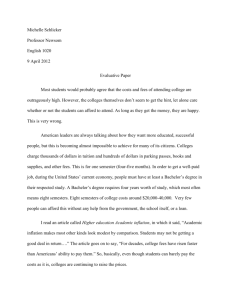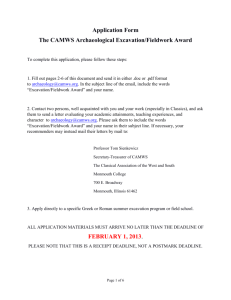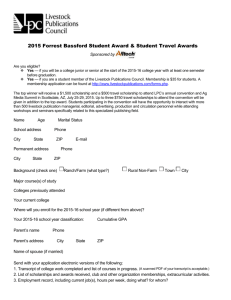Using Assessment Within the Financial Aid Office
advertisement
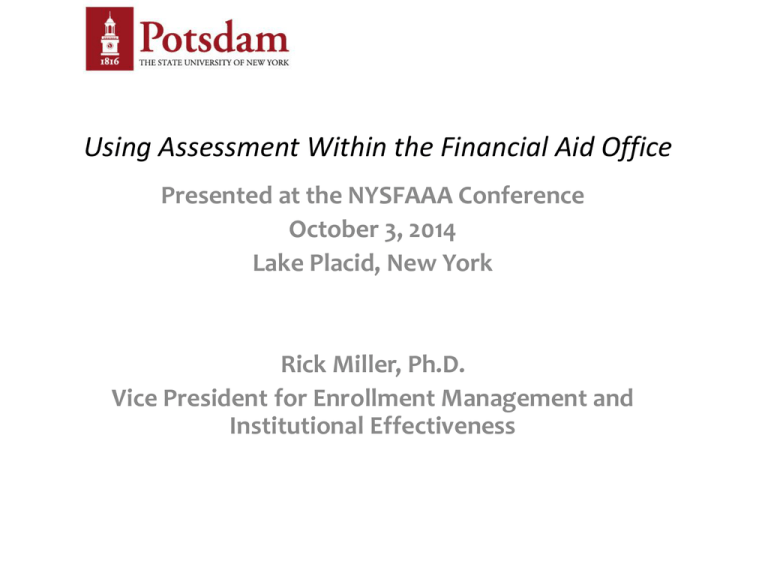
Using Assessment Within the Financial Aid Office Presented at the NYSFAAA Conference October 3, 2014 Lake Placid, New York Rick Miller, Ph.D. Vice President for Enrollment Management and Institutional Effectiveness Workshop Goals “if you don’t know where you are going, you might not get there” – Yogi Berra Discuss Assessment Framework Focus on Assessment Strategies and Methods for Financial Aid offices. Connect Financial Aid Assessment Findings with Enrollment Management and Institutional Planning Processes. Interactive and Discussion Oriented. Discuss emerging issues and ideas. 2 Assessment Pressures • Due to increasing workloads and budget constraints, assessment is a competing priority. • Middle States (MSCHE) expectations for assessment and continuous improvement. • Increasing demands from Federal Government for consumer protection, transparency, disclosure, etc. 3 Assessment for Improvement and Quality Assurance • The assessment process is about how we use assessment findings for planning and improvement. • Assessment can help Financial Aid units to organize systematically. • Focus on the “back end” of assessment (use results for decision-making and planning). 4 A Sound Assessment Strategy should be…… Pragmatic and interesting Simple and cost-effective Planned, not episodic Organized, systematic, and ongoing 5 The Assessment Plan Basics Office Mission Statement Goals Objectives Measures Summary of Findings and Actions 6 Sample Assessment Planning & Implementation Timeline STEP 11/14 – 12/14 1/152/15 3/15 4/15 Fall 2015 Spring 2016 5/16 – 5/17 Develop FA Mission Statement Develop FA Goals & Objectives Develop FA Means of Assessment & Metrics/Measures Conduct Assessments Feedback Loop & Use of Results 7 Sample Assessment Model Approach Unit Mission Goals Statement Means of Summary of Assessment Data & Measures Collected Use of Results 8 Suggestions Goals should be: • Linked to Unit Mission Statement. • Realistic (Achievable) - Resources and support currently available • Limited in Number (3-5) – Don’t try to assess everything all the time. Process can become too burdensome. • Measurable 9 Some Typical Measures Qualitative - Focus Groups - Student Interviews - Comment Cards Quantitative - Workflow Reports - Institutional Data - Surveys (e.g., assess student cost of attendance for student budget development) 10 Content Areas of Financial Aid Assessment Service Delivery & Student Satisfaction Productivity & Efficiency Award Processes & Fund Management (e.g., Scholarships, CWS, SEOG, Perkins, Cohort Default) Utilization of Technology 11 Linkages to Financial Aid Assessment Student Recruitment and Retention Examine Retention Patterns College Work Study Awards, First Generation Students, etc. Benchmarking: Graduation Rates & Pell Grants Award Processes & Fund Management (Internal Controls: Scholarships, CWS, SEOG, Perkins) Utilization of Technology (Social Networking) 12 Possible Approaches and Tools for Tracking Student Financial Aid • Quantitative – Data Warehouse/Dashboard Approach – MS Access – MS Excel – Statistical Analyses Using SPSS – Predictive Analytics • Qualitative – – – – Student exit interviews Focus Groups Comment Cards Student Opinion/Feedback Surveys. – Social Networking?? Discussion: How can financial aid data be utilized to improve student recruitment & retention? What variables should be studied? Where does the source data come from? Possible Examples of Subgroups and : - Admissions Profile Selectivity Ranges - EFC Range - Athletes (NCAA Reporting) - Program Specific (Major) Student Tracking Models • Cohort-Based - Can Track Financial Aid Records by: Subgroups (e.g., Gender, HS GPA, Honors, EOP/HEOP, etc.) • Term or Semester Based National Student Clearinghouse Can Track Students From Institution to Institution, Program to Program, etc. Financial Aid Quick Facts 2014-15 Award Cycle • 89% of the student population applied for financial aid. • 80% of the students applying for financial aid received needbased assistance. • 86% of students with financial need received need-based, self-help awards (Student Loans). • 27% received non-need scholarships & grants. • $14,273 is the average award (including scholarships, grants, and loans) per student of those receiving financial aid (excluding parent and alternative loans). • $21,531 is the average student debt rate upon graduation. References Nichols, K.W. & Nichols J.O (2000) The Department Head’s Guide to Assessment and Implementation in Administrative and Educational Support Units. New York: Agathon Press. 17

